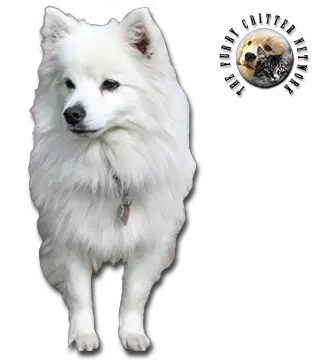Breed Standard
Head: Expression is keen, intelligent and alert.
Eyes: Eyes are not fully round, but slightly. They should be well apart, and not slanted, prominent or bulging.
Coat: The American Eskimo Dog has a stand-off, double coat consisting of a dense undercoat and a longer coat of guard hair growing through it to form the outer coat. It is straight with no curl or wave. There is a prounounced ruff around the neck which is more noticeable on dogs than bitches. Outer part of the ear should be well covered with short, smooth hair, with longer tufts of hair growing in front of ear openings. Hair on muzzle should be short and smooth. The backs of the front legs should be well feathered, as are the rear legs down to the hock. The tail is covered profusely with long hair.
Size: There are three seperate size divisions of the American Eskimo Dog (all measurements are heights at withers): Toy, 9 inches to and including 12 inches; Miniature, over 12 inches to and including 15 inches; and Standard, over 15 inches to and including 19 inches.
History
The American Eskimo Dog was originally bred to guard people and property and, therefore, is territorial by nature and a valiant watchdog. They are not considered an aggressive breed. But, due to the breed's watchdog history, American Eskimos are generally quite vocal, barking at any stranger who comes in proximity to their owners or their owner's territory.
In Northern Europe, smaller Spitz were eventually developed into the various American Eskimo Dog breeds. European immigrants brought their Spitz pets with them to the United States, especially New York, in the early 1900s, "all of them descended from the larger American Eskimo Dog, the Keeshond, the white Pomeranian, and the Italian Spitz, the Volpino Italiano."
Although white was not always a recognized color in the various American Eskimo Dog breeds, it was generally the preferred color in the US. In a display of patriotism in the era around World War I, dog owners began referring to their pets as American Spitz rather than American Eskimo Dog.
After World War I, the small Spitz dogs came to the attention of the American public when the dogs became popular entertainers in the American circus. Due to the popularity of the circus dogs, many of today's American Eskimo Dogs can trace their lineage back to these circus dogs.
After World War II, the dogs continued to be popular pets. Postwar contact with Japan led to importation into the United States of the Japanese Spitz, which may have been crossed into the breed at this time. The breed was first officially recognized as the "American Eskimo" as early as 1919 by the American United Kennel Club (UKC), and the first written record and history of the breed was printed in 1958 by the UKC. At that time there was no official breed club and no breed standard, and dogs were accepted for registration as single dogs, based on appearance. In 1970 the National American Eskimo Dog Association (NAEDA) was founded, and single dog registrations ceased. In 1985 the American Eskimo Dog Club of America (AEDCA) was formed by fanciers who wished to register the breed with the American Kennel Club (AKC). Following the AKC's requirements for breed recognition, the AEDCA collected the pedigree information from 1,750 dogs that now form the basis of the AKC recognized breed, which is called the American Eskimo Dog. The breed was recognized by the American Kennel Club in 1995. The stud book was opened from 2000 to 2003 in an attempt to register more of the original UKC registered lines, and today many American Eskimo Dogs are dual-registered with both American kennel clubs. The breed is also recognized by the Canadian Kennel Club as of 2006, but is not recognized elsewhere in the world The American Eskimo Dog is not entirely an internationally recognized breed, and since neither of the American kennel clubs are affiliated with the Federation Cynologique Internationale, fanciers wishing to participate in certain international dog shows will register their American Eskimo Dogs as the very similar American Eskimo Dog. This is done only by individuals wishing to participate in dog sports in international shows, and does not mean that the American Eskimo Dog and the American Eskimo Dog are the same. Although the American Eskimo is known as the American Eskimo Dog in several countries outside of the United States, the two breeds have actually developed somewhat differently since the American Eskimo was relocated to North America, over a century ago. It is not uncommon for American Eskimo Dog breeders to incorporate imported American Eskimo bloodlines into their breeding program to broaden the gene pool, and vice versa.
Behavior
The American Eskimo Dog is intelligent, alert and friendly, although slightly conservative. It is never overly shy nor aggressive. At home it is an excellent watchdog, sounding a warning bark to announce the arrival of any stranger. It is protective of its home and family, although it does not threaten to bite or attack people. The American Eskimo is a charming, affectionate and loving dog. Hardy and playful, they are excellent with children. Highly intelligent and willing to please.
The thick snowy white coat is easy to groom. Brush with a firm bristle brush twice a week. It should be brushed daily when it is shedding. This breed is an average shedder. American Eskimos will do okay in an apartment if it is sufficiently exercised. It is very active indoors and a small yard will be sufficient.
Function
Pet






